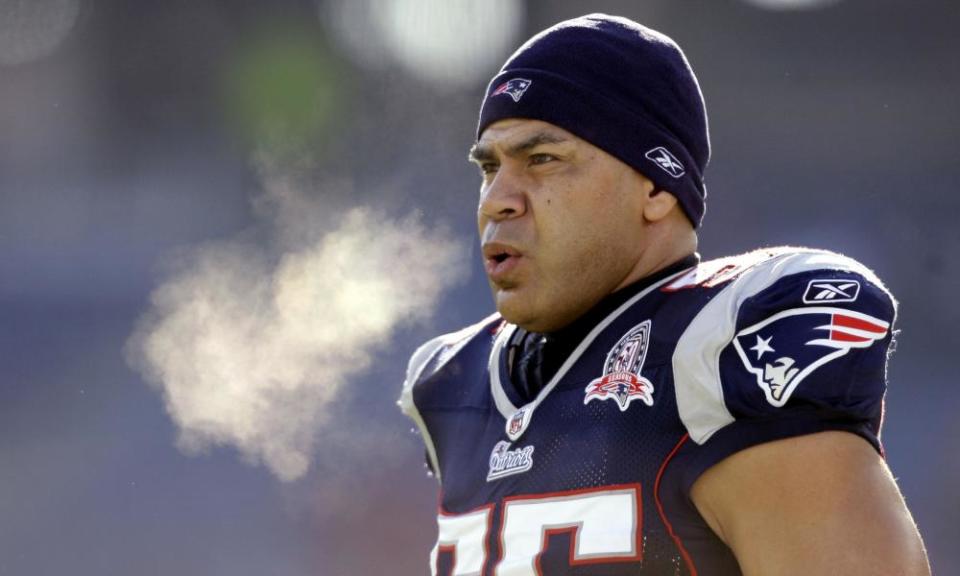Study links longer football careers to more severe cases of CTE
Research involving brains of former NFL players find 99% suffered from disease with symptoms that include memory loss and mood disorders

The largest ever study of cases of football players with the degenerative brain disease chronic traumatic encephalopathy (CTE) has, again, found a link between the condition and “prior participation in football”, particularly in professionals.
The study looked at the brains of 111 NFL players and found CTE in 110 of them, or 99% of those studied.
Researchers at Boston University and the Boston Veterans Affairs health system examined the brains of 202 high school, college, semi-professional and NFL players for evidence of the disease. They found increasingly severe CTE in players who had spent more time on the field.
“My hope is we’ll stop arguing about whether or not this is a problem, or whether or not it needs to be addressed,” said Dr Ann McKee of Boston University. “We need to take our heads out of the sand. It’s not going away because we want it to.”
CTE is associated with repeated blows to the head, including concussions. Symptoms include difficulty with attention and memory, dementia, mood disorders and headaches.
The players in the study had played football for an average of 15 years, and died at a median age of 66 years old. CTE can only be definitively diagnosed after death.
Researchers found the most severe cases of CTE in athletes who had played the longest, and at the highest levels. For example, the three high school football players identified with CTE had mild symptoms, but the majority of college and semi-professional players (56%) had severe signs of the disease. Eighty-six percent of professional players had severe CTE.
Players with the most severe CTE were also most likely to report clinical symptoms. Of the 84 participants with severe CTE, 80 (95%) had cognitive symptoms, 75 (89%) had behavioral, mood symptoms or both, and 71 (85%) had signs of dementia.
Researchers warned that their study can not be used to assess how many people who play football develop CTE, because their sample was not random. The brains were donated by family members, most of whom said their loved ones had reported CTE symptoms during their lifetimes.
The former Chicago Bears running back Mike Adamle said he and others have formed a “fraternity” of players who have suspected cases of the disease.
“The only thing I remember is he said, ‘You have symptoms that are concurrent with CTE,’” said Adamle, about a clinical diagnosis from his doctor. “We’ve got sort of a fraternity of players who just call each other up whenever we need it and for lack of a better phrase talk each other off the ledge … You really do get paranoid and depressed.”
CTE was at first believed to primarily impact boxers, but in recent years it has increasingly become associated with football, hockey and military service.
The NFL has for years been under sustained scrutiny because of the head trauma players endure. The NFL maintains that player safety is a top priority. However, as recently as 2016, a congressional investigation accused the NFL of seeking to influence CTE research with donations to the National Institutes of Medicine.
The NFL only acknowledged a link between degenerative brain disorders and the sport in 2016, after years of downplaying the links. The league also recently settled a class action lawsuit with players for $1bn.
“This is just the individuals who have come into our bank,” said McKee, noting it is unclear how many more players may have the disease. She said the need to be able to diagnose the disease while people are still alive is increasingly urgent. “We need to bring them reasons for hope and optimism,” she said.
In a statement to the Guardian, the NFL said it welcomed McKee’s research. “We appreciate the work done by Dr McKee and her colleagues for the value it adds in the ongoing quest for a better understanding of CTE. Case studies such as those compiled in this updated paper are important to further advancing the science and progress related to head trauma. The medical and scientific communities will benefit from this publication and the NFL will continue to work with a wide range of experts to improve the health of current and former NFL athletes.
“As noted by the authors, there are still many unanswered questions relating to the cause, incidence and prevalence of long-term effects of head trauma such as CTE. The NFL is committed to supporting scientific research into CTE and advancing progress in the prevention and treatment of head injuries.”

